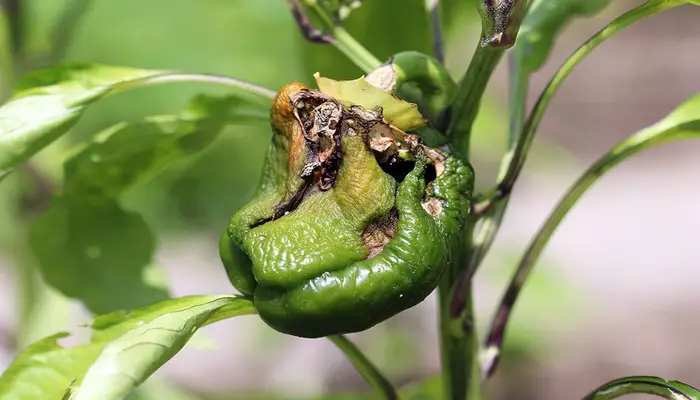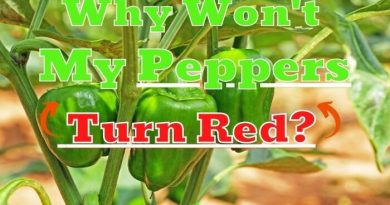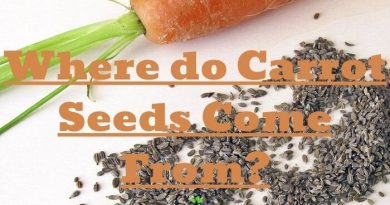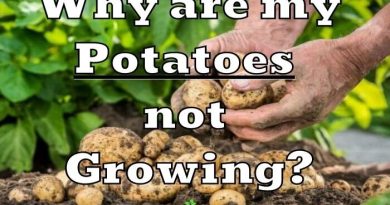Why are Peppers Deformed? [Answers You Need To Know]
As a fellow gardener, I have observed that peppers often grow with deformities or unusual shapes. There are various factors that can contribute to this issue. In this article, we will explore some of the common causes of deformed peppers and provide potential solutions.
The reason for the appearance of deformed or misshapen peppers is due to the following
Peppers become deformed due to a variety of reasons, including genetic factors, environmental stress, disease, and pest damage. Genetic factors can cause the peppers to grow in unusual shapes and sizes, while environmental stress such as extreme temperatures, moisture levels, and soil nutrient imbalances can also lead to deformities. Diseases such as bacterial spot, blossom end rot, and viral infections can also cause peppers to become misshapen, as can pest damage from insects such as aphids or thrips.
| Why are peppers deformed: |
|---|
| 1.Environmental Factors |
| 2.Disease and Pests |
| 3.Nutrient Deficiencies |
| 4.Genetic Factors |
However, sometimes peppers may develop deformities or abnormalities that can affect their growth, appearance, and taste. In this article, we will explore the various reasons why peppers may become deformed and provide some solutions to help prevent or treat these issues.
1. Environmental Factors that Lead to Deformed Peppers
Environmental factors such as temperature, water, humidity, and soil quality can affect the growth and development of peppers. If these factors are not within the optimal range for peppers, they can lead to deformities such as stunted growth, misshapen fruits, and discoloration.
Below are some of the environmental factors that can affect pepper growth:
Temperature
Pepper plants prefer warm temperatures between 70-90°F (21-32°C) during the day and 60-70°F (15-21°C) during the night. If temperatures fall outside of this range, it can affect the growth and development of the peppers.
High temperatures can cause the blossoms to drop and prevent fruit from setting, while low temperatures can slow down growth and cause misshapen fruits.
The lower air temperature in the initial stage of vegetation often causes a change in the thickness of the fruit walls. This defect is clearly visible on large-fruited, cone-shaped peppers. Deformed peppers develop slowly and do not grow to the desired size. In addition, in such fruits, the seed-bearer is often absent.
Bizarrely shaped growths appear next to the peduncle during prolonged cold snap (below 18 ° C). Due to the low temperature, the anthers (during the formation of pepper fruits) do not fall off, but continue to develop, acquiring fantastic shapes.
In unheated greenhouses, this phenomenon occurs in mid-spring – early summer, when the days are warm and the nights are still cold. In open ground, such growths on peppers can appear throughout the season.
Humidity
Humidity levels can also affect pepper growth. High humidity can create a conducive environment for diseases such as fungal infections, which can cause deformities such as spots and rot. Low humidity, on the other hand, can cause the leaves and fruits to dry out and affect the overall growth of the plant.
Lack of moisture can lead to sunburn of the plant, the pepper will change color and turn brown. Cracks appear on the fruits. It is necessary to regularly spray the stems and leaves.
Excess moisture can interfere with the pollination process. Pollen should not be wet. The optimal humidity is considered to be 65-75%. Watering is best done in the morning and mulch the soil with compost. This keeps the moisture in longer.
Incorrect humidity in the phase of flowering and ovary setting contributes to the wilting of fruits . Damp or overheated pollen loses its qualities, so the greenhouse needs to be ventilated daily, spray the plants with water and regularly monitor the humidity in the greenhouse, creating ideal conditions (65-75%).
Soil quality
The soil quality also plays a crucial role in the growth of pepper plants. The soil should be rich in nutrients and have good drainage. Poor soil quality can cause stunted growth, misshapen fruits, and a lack of flavor.
Adding compost or fertilizer to the soil can help improve the soil quality and promote healthy pepper growth.
By ensuring that these environmental factors are within the optimal range for pepper growth, gardeners can help prevent deformities in peppers and promote healthy growth and development.
Lack of fertilizers and top dressing in the ground leads to small twisted fruits, yellow leaves. It is necessary to fertilize the land every 10-12 days, observing the condition of the plant. Overfeeding the soil is harmful so it is recommended to have a balance.
2. Pests and Diseases that Lead to Deformed Peppers

Pests and diseases can also cause deformities in peppers. Common pests such as aphids, thrips, and pepper weevils can damage pepper plants and affect their growth and development. Bacterial spot disease and fungal diseases can also cause deformities such as spots, discoloration, and rot.
Aphids
Aphids are small, sap-sucking insects that can attack pepper plants. They can cause deformities in the fruits and leaves of the plant, and also transmit viruses that can cause further damage.
To prevent aphids, gardeners can use insecticidal soap or neem oil sprays, or introduce natural predators such as ladybugs.
The best way is to use natural enemies like ladybug larvae. Plant a nettle in a pot and place it next to the infested plants, aphids love nettles, remove the nettles before flowering, cut off the inflorescences and put them back in the greenhouse.
Thrips
Thrips are tiny, winged insects that feed on the sap of pepper plants. They can cause damage to the leaves and fruits of the plant, leading to deformities such as curling and scarring. To prevent thrips, gardeners can use insecticidal soap or neem oil sprays.
Pepper weevils
Pepper weevils are small beetles that feed on pepper plants. They can cause deformities in the fruits, including scars and holes. To prevent pepper weevils, gardeners can use insecticidal sprays or introduce natural predators such as parasitic wasps.
Bacterial spot disease
Bacterial spot disease is a common bacterial infection that affects pepper plants. It can cause deformities such as spots and lesions on the leaves and fruits of the plant.
To prevent bacterial spot disease, gardeners can use copper fungicides and practice good sanitation practices such as removing infected plant debris.
Fungal diseases
Fungal diseases such as powdery mildew and blossom end rot can also affect pepper plants, causing deformities such as spots, rot, and misshapen fruits.
To prevent fungal diseases, gardeners can practice good sanitation practices, such as removing infected plant debris and ensuring proper air circulation around the plants.
Is a fungus recognizable by a white mycelium on the pepper leaf surface. The plant is deprived of nutrients and the leaf withers and falls off.
Heavily infested plants should be removed, these can be composted, the fungus dies in the compost. It is important to ensure good ventilation, the plants should be watered from below, avoiding that the plant gets wet.
3. Nutrient Deficiencies
Nutrient deficiencies can cause peppers to become deformed, leading to reduced yield and quality of the crop. Some of the most common nutrient deficiencies that affect pepper growth include nitrogen, potassium, calcium, magnesium, and iron.
Nitrogen deficiency
N-deficient pepper plants express their problem with symptoms such as small yellow leaves, reduced growth rate, fewer flowers, and reduced or no fruit set. Peppers that eventually bear fruit produce malformed ones. Heavy rains and excessive watering make matters worse.
Potassium deficiency
Symptoms of potassium deficiency appear most often with the characteristic inter-venous chlorosis. Older pepper foliage may wilt and turn brown and burnt. There is a low fruit set rate and the peppers are smaller than usual.
4. Genetic Factors
Genetic abnormalities can cause deformities in peppers as well. While environmental factors such as inconsistent watering or pest infestations can contribute to these deformities, genetics also plays a role in determining the shape and appearance of pepper fruit.
Plant traits like plant height, leaf shape, and fruit characteristics are all governed by the complex genetic makeup of pepper plants.
The final phenotype, or observable traits, of the plant is produced by interactions between various genes and environmental factors. Fruit size and shape are specifically governed by some genes, and changes in these genes can cause deformities.
One example of a gene involved in fruit shape is the bell pepper gene. This gene, also known as Ca3, controls the formation of the bell pepper shape, with a flat bottom and four or more lobes at the top.
Mutations in this gene can result in flattened or misshapen fruit, such as those with only three lobes or with irregular bulges.
Another gene involved in pepper fruit shape is the fasciated gene. This gene controls the growth of the fruit stem and can cause the fruit to become elongated or fused together.
While some genetic variations may result in deformities, they can also lead to interesting and unique pepper varieties that are prized by gardeners and chefs alike.
Physiological disorders
Peppers can also become deformed due to genetic abnormalities. These can include physiological disorders such as blossom end rot and cat-facing.
Physiological disorders are abnormalities that can occur in peppers due to environmental factors or genetics.
Blossom end rot is a physiological disorder that can cause deformed peppers, characterized by a dry, brownish-black rot at the blossom end of the fruit.
Cat-facing is another physiological disorder that can cause deformed peppers, characterized by scars or indentations on the surface of the fruit.
Solutions and Treatments for Deformed Peppers
Deformed peppers can be a result of various factors, including environmental conditions, pest and disease issues, and genetic abnormalities. Addressing these factors can help prevent or minimize the occurrence of deformed peppers.
Here are some solutions and treatments that can be implemented:
Environmental Management:
Environmental factors such as temperature, light, and water can affect pepper growth and cause deformities. To prevent this, it is important to provide the right growing conditions.
Pepper plants require full sun exposure, warm temperatures, and consistent moisture levels. Mulching can help retain moisture in the soil, and regular watering is crucial. Additionally, providing support to the plants with cages or stakes can help prevent branches from breaking due to the weight of the fruits.
Pest and Disease Control:
Pests and diseases can also cause deformities in pepper plants. Regular inspection and management of these issues can prevent the occurrence of deformed peppers.
Insect pests such as aphids, thrips, and pepper weevils can be controlled with the use of insecticidal soap or neem oil.
Bacterial spot disease and fungal diseases can be prevented through proper sanitation practices, such as removing infected plant parts and avoiding overhead watering.
By taking steps to prevent and treat common pests and diseases, gardeners can help prevent deformities in peppers and promote healthy growth and development.
Genetic Selection and Breeding:
Genetic abnormalities can cause deformed peppers, and this issue can be addressed through genetic selection and breeding. Breeders can select traits that produce high-quality peppers, including uniformity of shape and size.
This can be done through careful selection of parent plants and controlled pollination. Additionally, genetic engineering techniques can be used to create peppers with specific desired traits.
What varieties of pepper are not prone to deformation
However, there are pepper varieties that are known to be less prone to fruit deformation:
| Pepper Variety | Fruit Shape | Fruit Size | Description |
|---|---|---|---|
| California Wonder | Bell | Large | One of the most popular bell pepper varieties, with a blocky shape and thick walls that make it resistant to deformations. |
| Sweet Banana | Banana | Medium | This pepper has a long, tapered shape that is less likely to deform than some other elongated varieties. It also has a mild, sweet flavor. |
| Gypsy | Bell | Medium | This pepper has a slightly elongated, tapered shape that makes it less prone to deformations than some other bell pepper varieties. It has a sweet, mild flavor. |
| Cubanelle | Banana | Medium | This pepper has a slightly curved shape and thin walls that make it less likely to deform than some other elongated varieties. It has a mild, sweet flavor. |
| Poblano | Heart | Large | This pepper has a heart-shaped, slightly curved form that is relatively stable, even when exposed to high temperatures. It has a mild to medium heat and a rich flavor. |
| Carmen | Horn | Medium | This pepper has a horn-shaped form that is resistant to deformations. It has a sweet, slightly tangy flavor. |
| Marconi | Horn | Large | This pepper has a long, tapered horn shape that is less likely to deform than some other elongated varieties. It has a sweet, fruity flavor. |
It is recommended to grow them to those gardeners who have already tried other methods and did not see improvement.
How to Avoid Deformation of Peppers
To avoid deformation, you must follow these rules:
- grow seedlings in a warm 68-75 °F (20-24 °C) room;
- regularly spray seedling bushes or install a humidifier in the room;
- plant seedlings in a permanent place only after the threat of frost has passed and the nights become warm;
- grow pepper in greenhouses or under film shelters;
- ventilate greenhouses daily, avoiding overheating (above 86°F);
- don’t waterlog pepper plants during the flowering period so that the pollen does not become sterile or wet;
- regularly inspect and prophylactically treat peppers from thrips.
Conclusion
In conclusion, deformed peppers can be a result of various factors, including environmental conditions, pest and disease issues, and genetic abnormalities.
Addressing these factors through environmental management, pest and disease control, and the genetic selection and breeding can help prevent or minimize the occurrence of deformed peppers, resulting in a more bountiful harvest of high-quality, uniform peppers.
Frequently Asked Questions
Yes, environmental factors such as wind damage or physical injury to the plant can cause the fruit to become deformed. Additionally, pollination issues and inconsistent watering can also contribute to fruit deformities.
Deformed peppers can still be eaten, as long as they are not showing signs of rot or other spoilage. However, they may not be as visually appealing or as easy to use in certain recipes.
Some pepper varieties are more prone to deformation than others, particularly those with thinner walls or larger fruit. Sweet bell peppers are often more susceptible to blossom end rot and deformation than other types of peppers. However, proper care and growing conditions can help prevent deformation regardless of the pepper variety.




